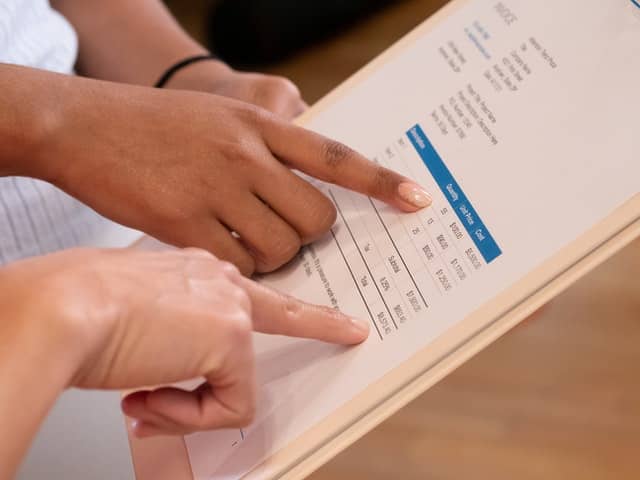Are you taking advantage of the incredibly awesome benefits online invoicing? Once you start invoicing your clients online, you’ll question why you ever used paper-based invoices in the first place.
But, are you getting the most out of online invoicing? If not, here are eight expert tips you should use when invoicing your clients online.
1. Utilize the right tools.
First and foremost, in order to start invoicing clients online you need to have an online invoicing platform. The right platform will allow you to not only invoice your clients electronically, they can also let you send and manage your invoices on your mobile device, accept payments, set-up recurring invoices, and track your billable hours.
While there is no shortage of options of online invoicing platforms out there, here are the leaders of pack:
- Due: Offers online invoicing, time tracking, project management, and credit card payments processing. It was designed specifically for companies of all sizes with thanks to its scalable solution.
- Freshbooks: A popular small business accounting software that comes with features like invoicing, payments, reporting, and time and expense tracking.
- Quickbooks: A well-known full-service accounting platform that does provide tools for invoices, online payment, and financial analysis.
- PayPal: Offers a simple and effective invoicing tool for requesting and accepting online payments.
Keep in mind that these tools offer a variety of features, so it’s important to choose the right solution for your business. Since most of these platforms offer a free trial and or demo you can compare them before making your final decision.
If you’re feeling overwhelmed, here’s an excellent post on the top questions you should ask before selecting an online invoice platform from Due’s Kayla Sloan.
2. Make it easy for people to pay.
“We live in a world that values ease and speed, and nowhere is this more true than when it comes to buying something. Below you’ll find some ways you can ensure that it’s easy for people to pay you,” writes our own Amanda Abella for an article for Money Under 30.
- Accept credit cards. “The most effective way to make it easy for people to pay you is to accept credit cards. Unfortunately, many people still try to avoid this because they are afraid of processing fees, so they try to get people to pay them with checks.” While same day ACH has become a reality, credit cards remain a more popular and convenient choice.
- Give multiple options. Not all of your clients or customers will use your invoicing platform. And, not all of your customers will be willingly to hand over their credit card number. In fact, only accepting checks or credit cards won’t cut it. Offering multiple options, such as digital wallets and Bitcoin, will ensure that your invoices will be paid on-time since it makes easier for them to pay the invoice.
- Accept payments on the go. “We’re living in a world where we can accept credit card payments with our cell phones. The truth is you never know when you’ll meet a great client or customer, so having the option to pay you on the spot makes things easier for everyone.” Best of all? You can snag a free credit card reader from Square or PayPal for free. There’s also this nifty tool called Flint that lets accept payments by snapping a picture of the credit card.
3. Personalize your invoices.
Invoices can be used for more than just getting paid for a product or service. It’s also an awesome branding opportunity, as well as becoming a marketing and money machine.
Due Co-founder and CTO Chalmers Brown suggests that you can achieve this by;
- Mentioning your client by name.
- Adding your logo or a headshot.
- Using your brand’s colors and fonts on your invoices.
- Showcasing your skills if you’re a creative person like a graphic designer.
- Using an authentic invoice.
- Mentioning how long you’ve been working together.
- Sending invoices in your customer’s local language or currency.
- Offering a discount, free piece of content, or referral.
- Getting to know your customers.
- Conveying a genuine thanks.
4. Invoice Your Clients Online Promptly.
“Once you complete a service or ship goods to a customer, send an invoice immediately. This will help you remain at the top of the customer’s mind and set a precedent for promptness,” writes NerdWallet’s Teddy Nykiel.
“If possible, allow customers to pay on the spot with a mobile payment system such as Apple Pay or Square. Some invoicing systems, including Wave, Flint Mobile and QuickBooks, also let business owners accept mobile payments,” adds Nykiel.
5. Offer recurring billing.
As noted by the fine folks at BluePay, waiting to invoice your clients isn’t good for business. For example, if you bill monthly there will be hidden costs like;
- Hours spent sending and receiving each invoice
- Money spent on materials such as paper, envelopes and stamps, along with any repairs
- Lost or misplaced invoices that have to be re-sent
- Time spent waiting for payments to clear
- The time spent chasing down a late payment.
Recurring billing, however, can eliminate those costs since it automatically invoices the client like clockwork on a set schedule and then automatically deducts the money from the user’s account. Simply put, it saves you time and money.
But, there’s some other perks of recurring billing. It’s better for the environment since it reduces the amount of paper you’re using and it can help with improved client retention.
6. Send online voices and attach files.
“Want to dramatically increase your chances of getting paid as soon as your customers receive your invoices?,” asks Ros Black on the Xero Blog. “With online invoices your customers simply click on a link you send them, then click on a Pay Now button. Your customers don’t even have to think about when or how they’ll pay you — they’re likely to pay you immediately.”
Services like Due and Xero provide an online invoice link every time you email an invoice. You just have to simply attach your payment service.
Black adds, “Give your customers all the information they need as soon as you invoice them. Otherwise, your customers might use lack of documentation as an excuse to delay payment.” You can accomplish this by attaching files directly to your invoices so that your clients and customers can review details like work schedules, contracts, and product specs.
7. Provide payment instructions.
Regardless of the size of your business, every invoice should include your customer’s information like their address, your contact information, billing details, itemized list of products and services, and a due date.
It should also provide payment instructions.
How should the customer pay? Should they send a check in the mail? Do they click a link to pay online or drop the payment in your digital wallet? You can answer those questions by including instructions in your invoices.
“I’m a strong believer that businesses should make payments as easy as possible on a customer,” writes Eric Rosenberg, who runs the blog Personal Profitability.
“Paying is the last interaction a customer has before leaving, and a smooth and easy experience is more likely to bring them back for repeat business. Think about how frustrating it is when you are waiting for the check or your credit card at a restaurant. A few minutes delay from the server may send you somewhere else the next time you are hungry. The same concept may apply in your industry as well!”
8. Be friendly until you have to be firm.
“If a customer is only a week or two beyond the due date, it’s important to avoid making assumptions. You’ll likely find over the course of growing your business that some customers habitually pay late.
The first time a payment from that client is late, you may fear no payment will be remitted, but if you use firm language, you’ll likely regret it when they reply that the missed payment was simply an oversight,” write Due Co-Founder John Rampton in an article for Startup Grind.
“Set a specific number of days in which you’ll allow late payments to go before you begin getting firm. The first late notice should be friendly, simply serving as a reminder with information on how to pay the bill.
The second notice can notify the customer of the late fees currently due, with the third notice becoming a little firmer. Don’t threaten “further action” until sufficient time has passed that you’re sure payment is being deliberately withheld.”
Thanks for reading! Do you want to create thought leadership articles like the one above? If you struggle to translate your ideas into content that will help build credibility and influence others, sign up to get John’s latest online course “Writing From Your Voice” here.



